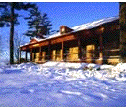






















|
|
Features of Turbulence Eddy Frequency Range For a pipe 2 cm in diameter with water flowing at
about 0.5 m/s ( |


|
                    
|
|
|
Dr. Goodarz Ahmadi |
Turbulence & Multiphase Fluid Flow Laboratory |
Department of Mechanical & Aeronautical Engineering
|